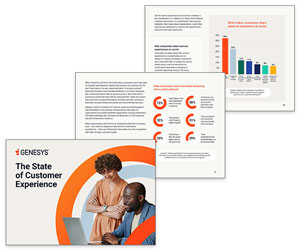Rick Kirkham of Customer Touch Point discusses how to bridge the gap between digital and telephony, why it’s a win-win for everyone and how to achieve it.
We all know that customer experience is high on the agenda for many businesses (and why), with many investing huge amounts of money in new digital platforms to better service customers. But is that investment paying off?
For me, it’s about balance, and that’s what ensures such investments pay off for everyone.
To achieve that balance, any business making an investment in digital customer experience must bridge the gap with live agent support.
Why? Because telephony is still the largest communication channel used by customers – and will likely be for a while yet.
Live telephony is still by far the largest communication channel used by customers, comprising 67% of inbound interactions (in the UK at least). Email is second with 20%, and webchat accounts for almost 4%.
Why Is Telephony Still So Important?
It comes down to emotion. Customers want reassurance, they want to feel trust in a relationship, especially when dealing with complex or highly emotional issues, and digital channels alone can’t often (some would argue if at all) provide that.
Yet, according to a Forrester survey of 45,000 consumers, “It is emotion — how customers feel — that is actually the biggest driver that keeps customers coming back for more.”
I truly believe that human contact generates positive emotions, whilst digital contact points reduce the natural occurrence of those positive emotions.
For me, this is why customers are still not that accepting of digital channels and why there needs to be a careful balance. Yes, continue to invest in digital but don’t forget what the customer wants and needs – human contact.
What’s Holding Things Back?
To help think about how we get the right balance, it’s first of all important to understand what the gaps are – and why they exist.
First of All, There’s the Technology Gap
Many digital channels are not always supported by live agents. If a customer first of all tries to solve their query online or via online chat but fails, they will naturally revert to phoning.
Now it’s at that point that systems often stop talking to each other. The call agent has no knowledge of how the customer has interacted with the website, what they’ve been looking for and so on. Which means the customer has got to repeat everything to the agent.
The frustration and negative emotion generated from the digital experience now has to be managed by the call agent.
And That Then Generates the Engagement Gap
This is the differences in emotion triggered between the two channels.
The inability to solve a complex or highly emotional issue online creates negative emotions – frustrations and anxiety, for example. That then has to be dealt with by the customer service agent at the end of the phone, making the call more challenging than it probably needed to be.
It’s worth pointing out again here that human contact creates positive emotion, offering trust and reassurance, so it’s something that has be considered.
After all, the relationships that we form with customers are both psychological and emotional.
The Future
Over time, customers will become more comfortable using automation, but we should be aware that this is a medium- to long-term process.
Sharp and dramatic pushes to digital and automation in the short term are unlikely to have a similarly dramatic positive effect on customer experience.
The ContactBabel Decision Makers Guide 2019 found there was a marked difference in how a business and the customer views preferences between agent vs. automation, as you can see below.
Customers want more agent contact than businesses realize, especially those over the age of 44, who just want one call to resolve their queries straight away.
The Customer View:

This chart was originally published in the ContactBabel Decision Makers Guide 2019
A marked difference to the Business View:

This chart was originally published in the ContactBabel Decision Makers Guide 2019
The Other Important Gap to Mention Briefly Here Is the Measurement Gap
This is the gap between what an organization measures (KPIs) and what actually matters to the customer.
For example, first contact resolution rate is often ignored as the primary indicator of the CX improvement programme’s success, despite both businesses and consumers indicating (in a variety of customer contact-related reports) that it makes the greatest difference to the actual customer experience.
Solving the digital telephony divide
So how do you solve the problem and end up with a seamless and effortless customer journey?
There are 3 core considerations…
- Understand what your customers want
There are significant differences in channel preference by age and socio-economic group, so businesses should look to see what their own customer base prefers and in which circumstances, so that support and investment can be planned accordingly.
Depending on the nature of an interaction – whether emotional, urgent or complex – multiple channels will need to be offered to the consumer base, especially live telephony, email and web self-service.
- Understand why they’re contacting you
A detailed understanding of your customers’ reasons for contact and where they sit on an emotion, interaction, complexity matrix provides a solid foundation from which to build an effective channel strategy.
The strategy will ideally both deliver for the organization right here and right now while also supporting medium- and longer-term goals of channel shift and reduced overall cost of contact.
- Change your governance processes
This channel strategy then needs to be reinforced by a change in governance process, which puts the agreed customer experience principles at the heart of decision-making rather than what are often seen as urgent operational needs that often override them.
Even the most effective customer journeys will be degraded over a relatively short space of time without this and return on investment reduced again.
Digital Alone Can’t Solve All of Your Customer Experience Needs
Digital is great. Web, social, apps. They all provide customers with a far easier, and much quicker, means of resolving queries and complaints, all of which can be done when it suits them, day or night. And for many people this is all they use and need when interacting with your business. We really do support (and often implement) digital CX strategies and tools.
However, what we do advocate is an integrated approach, where they work hand in hand, providing the customer with seamless engagement and an effortless experience. This delivers a better customer experience and generates significant operational savings, making it truly ‘win-win’ and sustainable.
What Does This All Mean?
That the telephony channel must be invested in and supported for some time yet. The key is then gradually linking your telephony experience to non-telephony channels in a way that adds value to both the business and its customers.
An increasing number of organizations have an ever-widening gap between their digital and live agent offering and, contrary to the intention behind it, actually pushes people back to telephony or live chat because digital feels like a deliberate barrier.
Once customers sense there is a barrier, it becomes much harder to influence their behaviour and gain the desired results behind the business.
If using the gradual approach and linking telephony to non-telephony channels in a way in which interaction data flows with the customer, you can create a sustainable shift to lower cost channels while (and this is crucial) still making customers feel that you’re there for them when they need you.
There is no doubt there are some great customer contact technologies available at an ever-reducing cost, but forcing them on customers is the not the answer because it generates negative emotions and undesirable behaviours, from the business point of view.
Picking the right technologies for you and your customer base and then following a graduated implementation method creates a ‘win-win’, sustainable situation.
Add exec-level buy-in and a strong CX-focused change governance process and you have a powerful combination that provides long-term customer and business benefits and a much-improved ROI on your CX investment.
To Conclude
We love digital – but we truly value the human touch. Don’t lose sight of one over the other.
Think omnichannel and move towards it – to maximize digital benefits it needs to enable interactions to flow through telephony and back again effortlessly (we can help you do that).
Invest in the right places and make sure your CX strategy is aligned to wider corporate goals.
Thanks to Rick Kirkham, the Managing Director of Customer Touch Point, for sharing this article with us.
Author: Rick Kirkham
Published On: 20th Mar 2020 - Last modified: 26th Feb 2025
Read more about - Expert Insights, Customer Service, CX, Rick Kirkham








































